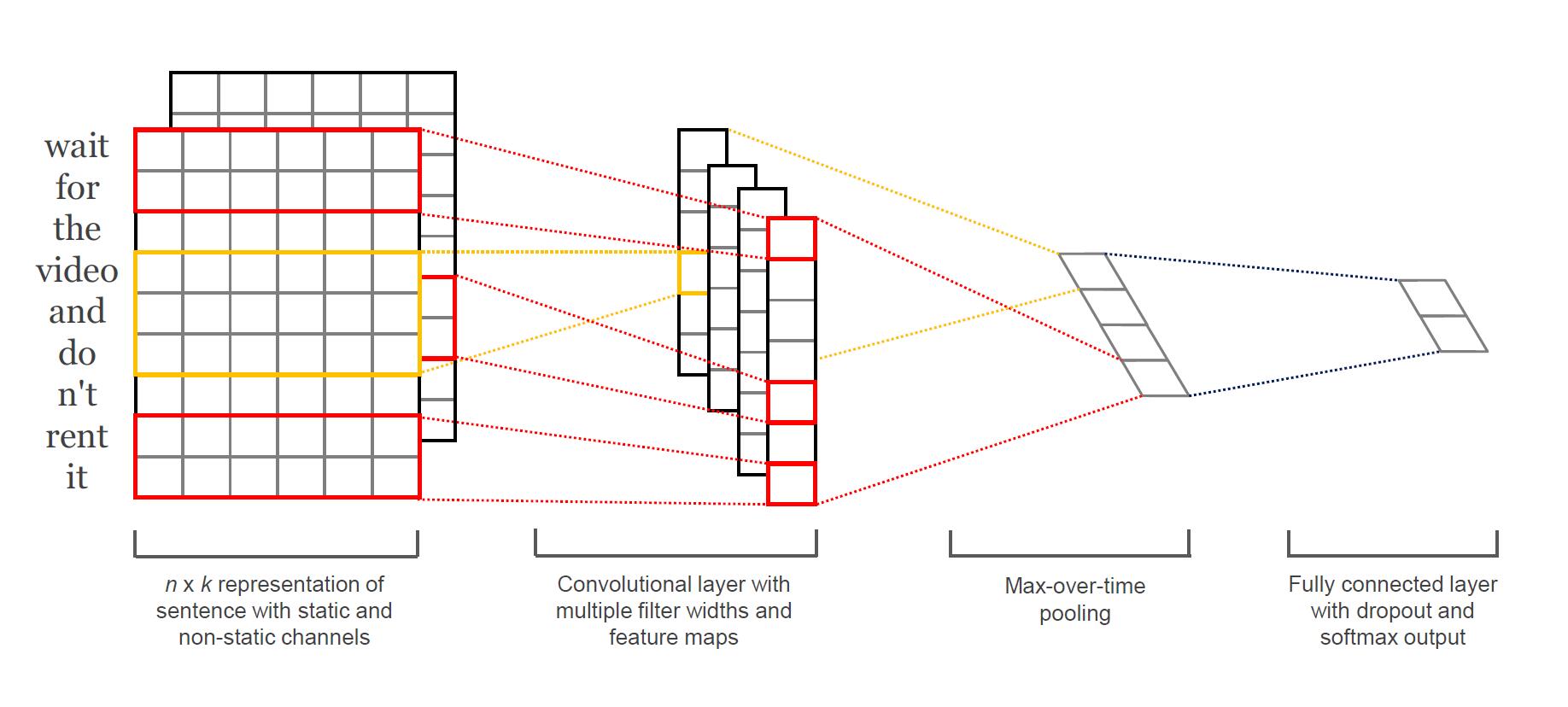stat441w18/Convolutional Neural Networks for Sentence Classification
Presented by
1. Ben Schwarz
2. Cameron Miller
3. Hamza Mirza
4. Pavle Mihajlovic
5. Terry Shi
6. Yitian Wu
7. Zekai Shao
Introduction
Model
Theory of Convolutional Neural Networks
Let [math]\displaystyle{ \boldsymbol{x}_{i:i+j} }[/math] represents the concatenation of words [math]\displaystyle{ \boldsymbol{x}_i, \boldsymbol{x}_{i+1}, \dots, \boldsymbol{x}_{i+j} }[/math] with concatenation operation [math]\displaystyle{ \oplus }[/math], [math]\displaystyle{ \boldsymbol{x}_{i:i+j} = \boldsymbol{x}_i \oplus \boldsymbol{x}_{i+1} \oplus \dots \oplus \boldsymbol{x}_{i+j} }[/math]. Then, a sentence of length [math]\displaystyle{ n }[/math] is a concatenation of [math]\displaystyle{ n }[/math] words, denoted as [math]\displaystyle{ \boldsymbol{x}_{1:n} }[/math], [math]\displaystyle{ \boldsymbol{x}_{1:n} = \boldsymbol{x}_1 \oplus \boldsymbol{x}_2 \oplus \dots \oplus \boldsymbol{x}_n }[/math]. Let [math]\displaystyle{ \boldsymbol{x}_i \in \mathbb{R}^k }[/math] denote the [math]\displaystyle{ i }[/math]-th word in the sentence, [math]\displaystyle{ i \in \{ 1, \dots, n \} }[/math].
A Convolutional Neural Network (CNN) is a nonlinear function [math]\displaystyle{ f: \mathbb{R}^{hk} \to \mathbb{R} }[/math] that computes a series of outputs [math]\displaystyle{ c_i }[/math] from windows of [math]\displaystyle{ h }[/math] words [math]\displaystyle{ \boldsymbol{x}_{i:i+h-1} }[/math] in the sentence. Hence, [math]\displaystyle{ c_i = f \left( \boldsymbol{w} \cdot \boldsymbol{x}_{i:i+h-1} + b \right) }[/math], where [math]\displaystyle{ \boldsymbol{w} \in \mathbb{R}^{hk} }[/math] is call a filter and [math]\displaystyle{ b \in \mathbb{R} }[/math] is a bias term, [math]\displaystyle{ i \in \{ 1, \dots, n-h+1 \} }[/math]. The outputs form a [math]\displaystyle{ (n-h+1) }[/math]-dimensional vector [math]\displaystyle{ \boldsymbol{c} = \left[ c_1, c_2, \dots, c_{n-h+1} \right] }[/math], called a feature map.
To capture the most important feature from a feature map, we take the maximum value [math]\displaystyle{ \hat{c} = max \{ \boldsymbol{c} \} }[/math]. Since each filter corresponds to one feature, we obtain several features from multiple filters the model uses which form a penultimate layer. The penultimate layer then gets passed into a fully connected softmax layer which produces the probability distribution over labels.
Below is a slight variant of CNN with two "channels" of word vectors: static vectors and fine-tuned vectors via backpropagaton. We calculate [math]\displaystyle{ c_i }[/math] by applying each filter to both channels and then adding them together. The rest of the model is equivalent to a single channel CNN architecture as described above.
Model Regularization
To prevent co-adaptation and overfitting, we randomly drop out some hidden units on penultimate layer by setting them to zero during forward backpropagation.
For example, consider a penultimate layer [math]\displaystyle{ \boldsymbol{p} }[/math] obtained from [math]\displaystyle{ m }[/math] filters, [math]\displaystyle{ \boldsymbol{p} = \left[ \hat{c}_1, \dots, \hat{c}_m \right] }[/math].
Datasets and Experimental Setup
Hyperparameters and Training
There are various benchmark for classification, for example:
MR:
Movie reviews with one sentence per review.
Class: positive/negative (Pang and Lee, 2005).
SST-1:
Standford Sentiment Treebank (An extension of MR) with train/dev*/test splits.
Classes: very positive, positive, neutral, negative, very negative.
dev set *: The set used for selecting the best performing model. (re-labeled by Socher er al. 2013)
SST-2:
Same as SST-1 but with neutral reviews removed and binary labels.
Class: positive/negative
Subj:
To classify a sentence as subjective or objective.
Class: subjective/objective (Pang and Lee, 2004)
TREC:
TREC quetion dataset, classfying a querion into 6 quesion types
Class: question about person, location, numeric information. etc (Li and Roth, 2002).
CR:
Customer review towards various products (i.e. cameras, MP3 etc.).
Class: positive/negative reviews. (Hu and Liiu, 2004)
MPQA:
Opinion polarity detetion subtask of the MPQA dataset.
(Wiebe et al., 2005).
Pre-trained Word Vectors
Model Variations
CNN-rand:
CNN-static:
CNN-static:
CNN-non-static:
CNN-multichannel:
